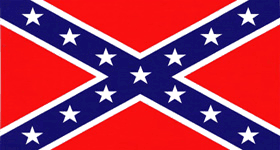 |
Civil War Battles |
|
State War Records |
| AL - AK - AZ - AR - CA - CO - CT - DE - FL - GA - HI - ID - IL - IN - IA - KS - KY - LA - MA - MD - ME - MI - MN - MS - MO - MT - NE - NV - NH - NJ - NM - NY - NC - ND - OH - OK - OR - PA - RI - SC - SD - TN - TX - UT - VT - VA - WA - WV - WI - WY |
The Battle of Picacho Pass
April 15 1862 in Picacho Pass, Arizona
 |
|||||||||||||||||||||
|
On April 15, the western-most "battle" of the American Civil War was fought on the flanks of Picacho Peak, a rocky volcanic spire situated 50 miles northwest of a small Sonoran town named Tucson. In 1862, this area was virtually deserted due to its natural desolation, and the fact that all Union army troops had departed the previous year, leaving the local settlers and Indians to do as they wished.
Into this volatile scene marched the newly formed Confederate Army, whose formations had declared the entire New Mexico Territory for the Confederacy on August 1, 1861. After securing the Rio Grande Valley, the local Confederate commander dispatched Capt. Sherrod Hunter to Tucson, which he occupied on February 28, after a freezing winter march. With its new garrison of 75 Confederates, Tucson was now the furthest point west in the Confederate Empire. They enjoyed the earnest support of the local civilians, as long as they and their brethren helped to keep the Indians suppressed, a task which drew considerable manpower away from the tiny Confederate force.
The Union reacted quickly to the Confederate seizure of the Southwestern Territories. Indeed, these events turned out to represent the most complete takeover of Union territory the Confederacy managed during its existence. Once the Confederate threat in California subsided, a small force of roughly 1,400 troops under Brig. Gen. James H. Carleton was dispatched from Fort Yuma to march on Tucson, hundreds of miles across the Sonoran desert. Hearing word of this "California Column," Hunter pushed north to the Gila River, encountering his first Union troops when the leading detachment of California cavalry blundered into Hunter's men as they captured a flour mill.
After interring the Union cavalrymen and giving the flour to the local Indians, Hunter returned to Tucson, first dispatching a small party of Confederate cavalry to ride west along the stage road, burning hay which had been left piled for the approaching Union troops. This party of Confederates rode to within 80 miles of Fort Yuma, finally stopping when they encountered the first Union pickets, whom they drove off, wounding one. This little known skirmish must have been the true "westernmost" fight of the Civil War.
By early April, the California Column had reached an area near present day Casa Grande. From there, they dispatched a group of scouts to reconnoiter the remainder of the route into Tucson. It was this detachment of the 1st California Cavalry which ran into Hunter's men at Picacho Pass on April 15. Hunter's strong detachment of pickets had occupied ambush positions up on the rocky slopes of Picacho Peak, from which they commanded a wide view of the stage road. The Confederates were waiting in ambush, and only part of the Union cavalry troopers entered the pass via the stage road. The position itself was so obviously an ambush point, that the approaching Californians had split in two, sending part of their force to circle the dangerous position as a precaution.
These precautions were justified, because at 2:00 P.M., the Union cavalrymen entering the pass were fired upon by Hunter's waiting men. Two Union troopers were injured, and the rest went to the ground in disorder. At this time, the other Union force came up on the flank of the Confederate skirmish line, capturing 3 of Hunter's men. Encouraged by this victory, Union Lt. James Barrett waved his men forward against the remaining Confederate cavalry, who laid down heavy fire, killing and wounding 4 more Union soldiers, including Barrett. After withdrawing and regrouping, the Union cavalry continued trading shots with the Confederates until late afternoon, when they withdrew and slowly returned to the main body to the north.
The "battle" at Picacho Pass was a tiny skirmish compared to the great battles in the east. Hunter's Confederates continued to be outnumbered, and they were too far from the main Confederate army on the Rio Grande to receive regular supply or reinforcement. Carleton's California troops finally arrived in Tucson, only to discover that Hunter had retreated. Hunter's east-bound troops were attacked repeatedly by Apaches based in the Chiricahua Mountains. The Confederates even armed their Union prisoners as the march became a fight for survival. The tired Confederates arrived on the Rio Grande River on May 27, bringing the Confederate invasion of "western" Arizona to an end.
